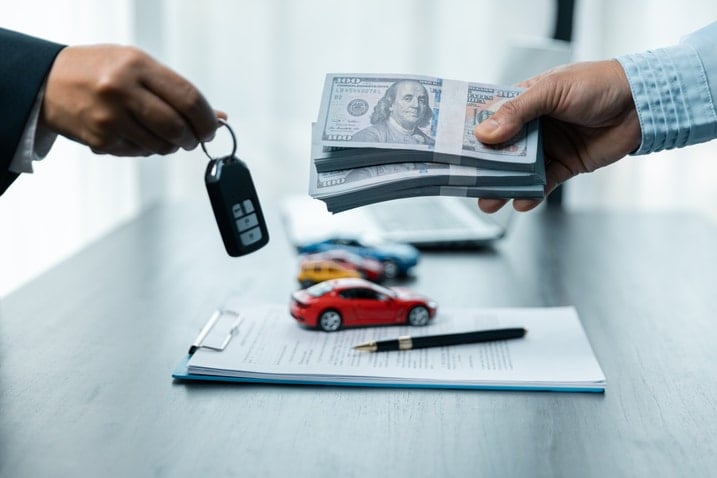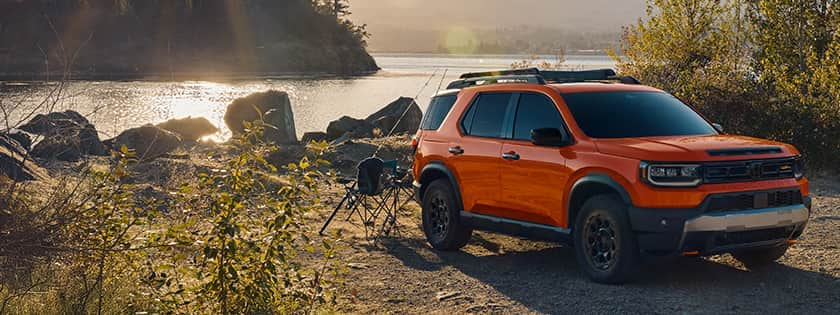1. Get your car's estimated trade-in value
To determine if you're being offered a reasonable price on your trade-in car, you first must know what it is worth. (People sometimes reference the car's Kelley Blue Book value.) Since you're already here, we recommend using the Edmunds car appraisal tool. You can enter your vehicle's license plate, the vehicle identification number, or choose the make and model. Next, follow the prompts to select the options your car has and answer questions about its condition. It is important to accurately take stock of all the car's options and be honest about the condition. Note that only a small percentage of cars are actually in "outstanding" condition. Most vehicles that are well maintained are considered in "clean" condition. When in doubt about the condition level, it's best to err on the side of caution.
On the results page, you'll get an offer from one of our partnered dealerships. Note that the actual figure can vary as the car will still need an in-person appraisal. For added reference, you'll also see an "Edmunds appraisal report." It defaults to the average trade-in value, but you can click on "Private Party" to see if the added value is worth the effort, or click on "Dealer Retail" to get an idea of what your car would sell for at a dealership. You can also see how the different condition levels affect the value. Email this figure to yourself to have it on hand when you visit car dealers.
2. Positive vs. negative equity
Now, is your appraisal value enough to pay off the loan? Depending on the answer, here's how it can play out.
Scenario A – Positive equity: Congratulations! This is the best-case scenario. You have equity in the vehicle and can use the remaining balance toward the purchase of your next car. Proceed to step 3.
Scenario B – Negative equity: If the vehicle's appraised value isn't enough to pay off the loan, this is considered negative equity or being "upside down." The remaining balance still needs to be paid in order to move on to another vehicle. From here, you have a few options. If the remaining balance is small enough not to make a dent in your savings, you can simply pay the difference out of pocket.
If the remaining balance is high, the smart thing to do is realize that the timing isn't right and keep driving your current vehicle until you have some equity or the loan is paid off. You can also try refinancing the current car loan, which can lower your payments if you secure a better interest rate.
Other folks might be in dire need of a car or simply cannot wait until they gain equity. In this case, when the deal is made for the new car, the remaining balance from the trade-in will be folded into the new loan. It is convenient, but it has consequences. Your payments will be higher, you'll be paying more in interest charges, and it continues a cycle of negative equity that is hard to break out of until you fully pay off the loan.
3. Proceed with the in-person appraisal
Your goal now is to get a firm offer. If you appraise your vehicle on Edmunds, you can follow the prompts to make an appointment for an in-person appraisal. Once your car has an official offer, you can either use it as a baseline for your negotiating, or if you're comfortable with the price, you can take them up on it and walk away with a check in hand, assuming all your paperwork is in order.
The alternative method is to call the used car manager at your local dealership to set up an appointment for an appraisal of your vehicle. Timing is critical here. Most dealerships will only have one person appraising potential trade-ins. If you show up on a Saturday afternoon, you could be waiting for a while. Try to schedule the appraisal for a weekday morning when it's less hectic. There are some dealerships that offer a "blind trade" option. This is when the dealership sends you an appraisal offer via email without the need to see the vehicle. You would send the dealership your vehicle identification number along with photos of the exterior, interior, and odometer reading. The dealership would assess the photos and come up with an offer.
Keep in mind that the trade-in price you're offered at the dealership can vary depending on several factors, including the car's condition, the dealer's current inventory, and the likelihood the car will sell. There may also be special promotions around trade-ins. More about that later.
If you follow the steps here and have an Edmunds appraisal, you will already have a reference point to compare the dealer's offer. If not, you might want to try to get appraisals from two dealers.
Here's a good strategy you could try: Take your car to a dealer other than one that sells your car's brand. For example, take your Toyota RAV4 to a Chevrolet dealer. This way, your car won't be competing with six other RAV4s on the lot. A non-Toyota dealer, which is very likely to sell used cars of other brands, might offer you more for the RAV4 than the Toyota dealer.
Need help with buying? At this point, we'll assume you know which car you want, but if you need help, read "What car should I buy?" Similarly, if you need help finding a new car in your price range, take a look at Edmunds' affordability calculator.
4. Negotiate and close the deal
Once you have appraisals, you have a couple of options. You can either take one of the offers you have or negotiate for a better price. (This isn't an option if your offer is from a no-haggle dealership such as CarMax.) If you are upside down on the car and need to fold the loan balance into your next car's financing, the dealership where you're purchasing the new vehicle is the best place to do so.
When deciding between two dealerships with similar offers, you might want to lean toward the one at which you intend to buy your car. This tactic gives you some leverage since you're giving the dealership business on both the trade-in and the car purchase.
The first trade-in offer at a dealership is often on the low end, so there can be room to negotiate. Say something like this: "I intend on buying a car from you today, so if you can improve on the trade-in price, we can move forward on the deal."
Another strategy is to use the Edmunds appraisal as a guide. Say something like this: "I've done some research on this car and it looks like the Edmunds trade-in value is slightly higher than your offer. I realize it's an average, but can you beat this price?"
You might be able to make the day you trade in work to your advantage. Target the end of the month, when the dealer may be more willing to give you an attractive offer. You can also look for special promotions, such as when a dealership offers extra cash as part of a trade-in event meant to beef up the used car inventory.
There's no guarantee that these strategies will work. "Your mileage may vary," as the saying goes. But if you've obtained more than one offer, you should have some options. If you keep getting the same offers for your vehicle and none of them are what you had in mind, you may have to temper your expectations. These offers might very well be the market value of the car no matter what you think it should be worth.
At this point, you can either take what you're being offered or try to sell the car yourself. Some people may even choose to keep the car as a daily driver rather than pile miles onto the new car.
When you're car shopping, keep negotiations for the new car and your trade-in separate. The trade-in amount should be written in the contract as a credit against the purchase price of the car. In some states, you only pay sales tax on the difference between the new car and the trade-in. This means that on top of what you receive for your trade-in, you are paying less sales tax on your new car. This tax advantage is a net savings for you and could make you decide that a trade-in is worth it. Details are in our story "What New Car Fees Should You Pay?"
5. Common trade-in mistakes
There are some common mistakes that people make when they're trading in a car. Here are a few tips on how to avoid them:
Repairing the car: People sometimes try to fix dents on their cars or throw on a new set of tires, thinking it will significantly add to the value of their trade-in. This seldom works. The dealer can usually fix flaws and put on new tires for substantially less than you can.
Overestimating the value: People tend to get sentimentally attached to their cars and often think they're worth more than they actually are. They look for the highest car value on an appraisal site for their vehicle and treat it as though it's set in stone. But appraisals are averages, meaning some dealers offer people less and others more. Rather than arguing over the car's value, your efforts might be better spent on negotiating the price of your new car.
Hiding information: Some shoppers fib, claiming to have a high trade-in offer in the hopes the dealer might try to beat it. This tactic rarely works in car deals. An experienced appraiser will either see right through the inflated offer or call your bluff by asking to see the estimate in writing. If your offer is for real, display it proudly. If you don't have an offer, don't try this.
Also, some shoppers wait until the last minute to mention that they have a trade-in as part of the car buying deal. This is one of the top car buying myths. It's best to be up front about the trade-in from the beginning.
If you follow these steps and sidestep the common pitfalls, the trade-in process will run smoothly. The key is to know what your car is worth, shop around, and be realistic about the offers you get.


 by
by  edited by
edited by 


